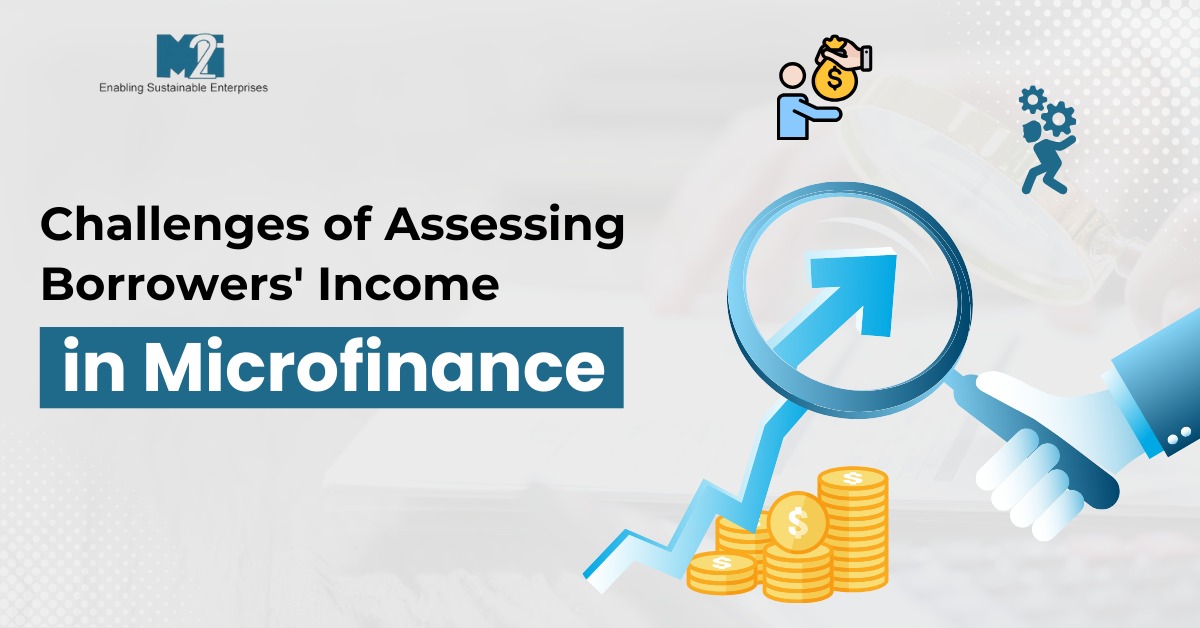
Challenges of Assessing Borrowers' Income in Microfinance
In the microfinance sector, accurately assessing a borrower’s income is critical for ensuring responsible lending, preventing over-indebtedness, and fostering sustainable growth. Yet, given the nature of the borrower demographic, most of whom are part of the informal economy, this task presents significant challenges. This paper explores the complexities and barriers to effective income assessment in microfinance, highlighting the implications for lenders, regulators, and borrowers.Nature of Informal Income and Seasonal Variability
One of the most fundamental challenges in microfinance income assessment is the informal and often irregular nature of borrowers' incomes. Unlike salaried individuals with predictable earnings, microfinance clients frequently rely on seasonal work, daily wages, or small-scale entrepreneurial ventures. Many borrowers, particularly those in rural areas, work in agriculture or allied sectors, where income can vary dramatically based on harvest cycles, market prices, and climate conditions.
For example, a borrower involved in farming or small-scale vending may have fluctuating daily earnings, which makes it difficult to capture an accurate, consistent picture of household income. Additionally, some households rely on multiple income sources, such as seasonal farming combined with temporary labor, complicating income estimation. Given these variables, microfinance institutions (MFIs) are left to estimate income through proxies or sporadic observations, which can be unreliable.
Lack of Documentation and Formal Financial Records
In most cases, microfinance borrowers do not possess formal income documentation, such as payslips, tax returns, or audited financial records. Without standardized financial records, MFIs cannot cross-verify self-reported income, increasing the risk of inaccurate assessments. Many borrowers in the informal sector do not maintain personal accounts or records of their transactions, making it challenging for MFIs to gather reliable data on past earnings or estimate future income.
This lack of documentation forces MFIs to rely on alternative assessment methods, such as in-person interviews or observational assessments of assets. While these methods can offer some insights, they are vulnerable to subjective interpretation and bias, particularly if loan officers are not adequately trained in these methods.
Risk of Over- or Under-Reporting by Borrowers
Since many borrowers are aware that their reported income affects their loan eligibility and terms, there is an inherent risk of income misrepresentation. Some borrowers may understate their income to ensure affordable installment amounts, while others may exaggerate income levels to qualify for larger loans. Such variations, whether intentional or due to misunderstanding, complicate the task of accurate income assessment.
This situation is particularly problematic given that repayment obligations are now tied to income levels. If an MFI overestimates income, it risks lending an amount the borrower cannot repay. Conversely, if income is underestimated, borrowers might receive less credit than they could responsibly manage, thereby limiting their access to funds that could be beneficial for their livelihoods.
Technological Limitations in Data Verification
Although credit bureaus have made progress in tracking borrower debt across institutions, their capability to verify income is limited. Bureaus typically compile data on loan balances and payment histories, but they do not have direct access to income verification tools, especially for informal income. This limitation hinders their ability to validate the debt-to-income ratio required under current regulations.
The implementation of digital financial services and the push toward financial inclusion have created opportunities for gathering data on borrowers' transactions, such as mobile payments or savings patterns. However, these data sources are still in developmental stages and are not universally applicable, particularly in remote or underserved regions where digital adoption remains low. For now, technology in microfinance is more effective at tracking debt rather than income, leaving MFIs with an incomplete picture of a borrower’s financial standing.
Regional and Economic Differences in Income Potential
Income assessment methods also struggle to account for the regional disparities in earning potential, economic opportunities, and living costs. For instance, income in rural or semi-urban areas may differ significantly from that in metropolitan regions, even for individuals in similar professions. Variances in income potential across regions can lead to miscalibrations when MFIs apply a standardized income assessment approach.
Additionally, borrowers within the same income bracket in different regions may face different expenditure patterns, thus impacting their true debt servicing capacity. Without the means to incorporate these regional variations into their assessments, MFIs are prone to adopting generalized standards that may not reflect the actual repayment ability of borrowers.
Regulatory and Industry Pressure to Meet Growth Targets
As MFIs compete to grow their market share and reach underserved populations, there is industry pressure to expand lending rapidly. This competitive pressure can sometimes lead MFIs to lower their income verification standards or rely on faster, less thorough assessments. Moreover, regulatory changes that encourage increased financial inclusion can sometimes inadvertently foster an aggressive lending environment.
In the absence of reliable income data, MFIs may approve loans based on incomplete assessments, leading to higher default risks. A long-term approach that balances responsible growth with effective risk management is essential to mitigate these risks, but this balance can be difficult to achieve under competitive and regulatory pressures.
Potential Solutions and the Path Forward
To address these challenges, several strategies can be employed:
- Improving Data Collection and Analysis: Leveraging alternative data sources such as mobile transaction histories, utility payment records, or remittance patterns could offer indirect indicators of income. Incorporating machine learning models and data triangulation methods can help MFIs improve the accuracy of income assessments.
- Standardizing Definitions and Assessment Protocols: Developing a standardized definition of household income and training loan officers in its application would reduce inconsistencies. Regulators and Self-Regulatory Organizations (SROs) could collaborate with MFIs to establish clearer guidelines for income verification.
- Strengthening Credit Bureau Capabilities: Expanding credit bureau functionalities to include income and cash flow tracking tools, while still respecting borrower privacy, could enable MFIs to make better-informed lending decisions.